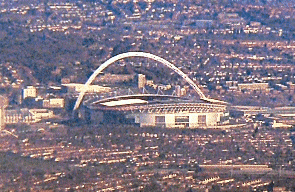|
Addicks
The nickname of Charlton
Athletic FC. The word almost certainly dates from the earliest years of the club’s existence when local fishmonger,
and later club vice-president, Arthur Bryan used to provide post-victory suppers of haddock and chips for the players. Allegedly,
Bryan would serve the less popular cod in the event of a defeat. The team was soon dubbed ‘the Haddocks’, which
subsequently became corrupted to ‘the Addicks’. The club has preferred ‘Robins’ and ‘Valiants’
at times in the past but now officially endorses the fishy sobriquet.
The Arsenal Stadium Mystery
A 1939
detective film directed by Thorold Dickinson (1903–84), in which an opposition player dies by poisoning during a match
at Highbury stadium and Scotland Yard is called in to investigate. Several Arsenal players of the time appeared in the film,
which was one of the earliest to exploit the British love of football, and one of the very few such productions to have been
critically acclaimed, despite its low budget.
It’s a slight, B-movie murder mystery, more of a ‘quota
quickie’, so it’s not really fair to compare it to the English Hitchcocks. But it’s a lot of fun …
Dickinson strikes me as a very confident director here, willing to play with the material, to have fun with it.
Martin
Scorsese, interviewed in Sight & Sound (November 2003)
Celery
A laconic bawdy ditty chanted by some supporters of Chelsea FC. Its popularity led a small minority to begin throwing sticks
of celery onto the pitch during games; the club clamped down hard on the practice.
Chelsea have banned celery from Stamford Bridge
and ordered fans to stop throwing it during matches after the Football Association launched an investigation into instances
of salad tossing at their recent matches.
The Guardian
(16 March 2007)
A reader adds: The chant first started
at Gillingham, season of 1995–6, because celery’s low calorific value is well-known, and at that time they had
the heaviest goalkeeper in the league, a man by the name of Jim Stannard. The joke, however, was on the fans: Stannard let
in just 20 goals all season, kept 29 clean sheets, and the club won promotion. [Thanks to James McLaren]

Craven Cottage
Originally a cottage
orné built in 1780 on the west side of the Fulham peninsula as a country retreat for for William Craven, 6th Baron Craven
(1738–91). The cottage burned down in 1888 and Fulham FC established a permanent home on its site in 1896, 17 years
after the club’s foundation. In recent times plans for the club to radically rebuild the stadium, or possibly to move
elsewhere, have come to nothing and Craven Cottage is likely to remain in roughly its present form for the foreseeable future.
From
1980 until 1984 Craven Cottage was also home to Fulham Rugby League Club. Fulham RLFC played at other London stadia from 1984,
eventually mutating into Harlequins Rugby League.
Eagles
The present-day nickname
of Crystal Palace FC, promulgated in the mid-1970s following the introduction of a new crest that relegated the formerly dominant
image of the glass exhibition hall to secondary, stylized status and added a red and white football surmounted by a blue eagle
– later redrawn to look more eagle-like. The redesign was said to have been influenced by the emblem of the Portuguese
club Benfica, which is also nicknamed the Eagles (as águias) and uses the bird as a symbol of ‘independence,
authority and nobility’. Crystal Palace had formerly been known as the Glaziers.
Fever Pitch
A popular sociological
study (1992) by Nick Hornby (b.1957), subtitled ‘A Story of Football and Obsession’. It charts the author’s
personal relationship with the game as a fan (from the age of 10) of Arsenal FC. The title has obvious punning connotations.
A film version (1996), directed by David Evans and starring Colin Firth, presented the original as a romantic comedy. An Americanized
version (2005) concerned actor Ben Fallon’s character’s obsession with the Boston Red Sox.
no one likes us, we don’t care
The
unofficial motto of Millwall FC, much chanted by the club’s fans to the approximate tune of ‘Sailing’ (Gavin
Sutherland, 1972). Also the title of a book by Garry Robson, subtitled ‘The Myth and Reality of Millwall Fandom’
(2000). For much of the late 20th century, sections of the media portrayed Millwall supporters as football’s worst hooligans,
sometimes labelling them as white, working-class racists. The chant reflects the fans’ attitude to being thus stigmatized.
No one likes us, no one likes us,
No one likes us, we don’t care.
We are Millwall, super Millwall,
We
are Millwall, from the Den.

|
| Wembley Stadium today |
In footballing history, a nickname for the FA Cup Final of 28 April 1923
between Bolton Wanderers and West Ham United at Wembley. Thousands of fans spilled on to the pitch before the start of the
game, and it required mounted police, and in particular Constable George Scorey on his 13-year-old white horse, Billy, to
clear it before the match could begin. Although Scorey was only one of several mounted policemen on duty that day, his conspicuous
white horse gave the name by which the final has always been referred to since. Bolton won the match 2–0.
Yid or Yiddo
In
most contexts this is a derogatory term for a Jew. However, to many supporters of Tottenham Hotspur FC it is a badge of honour.
It derives from the club’s traditional popularity among north London’s Jewish community. Although originally used
disparagingly by some supporters of opposing teams, the term was taken up from the 1960s or 70s by home fans, who nowadays
– whether Jewish or not – often refer to themselves as the ‘Yid army’. The club has voiced concern
about the phenomenon but, as one Jewish supporter has argued on a fans’ message board: ‘The more the word “Yid”
is used in the context of the mighty Spurs then the less power it has as an insult.’
|

